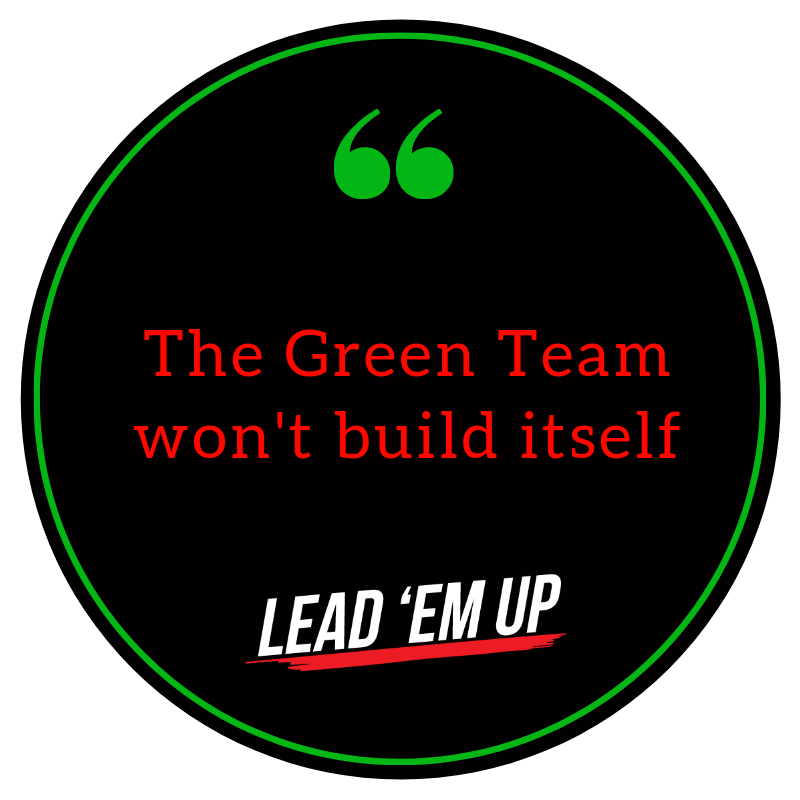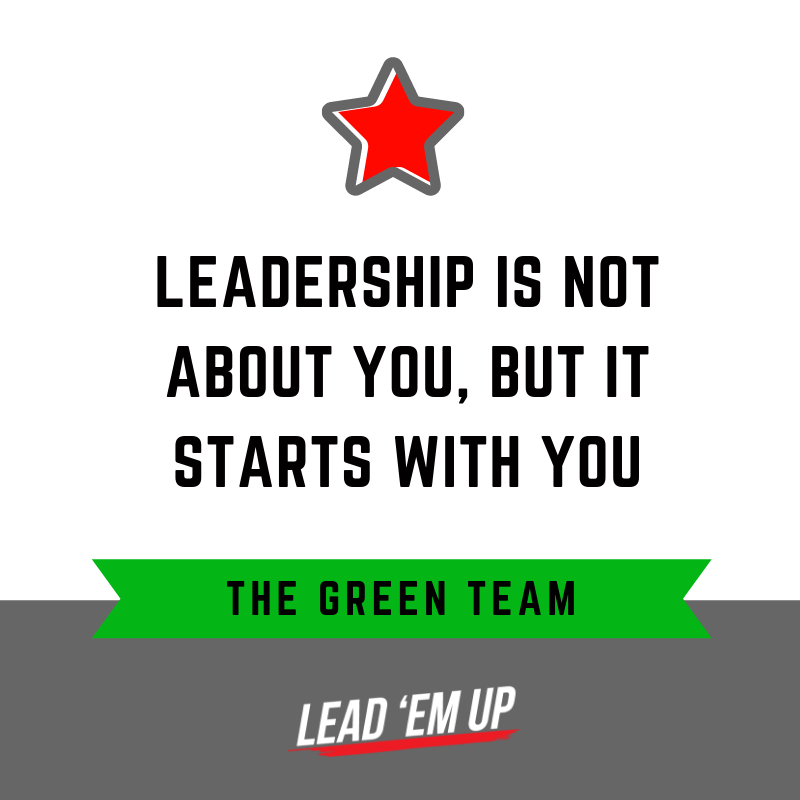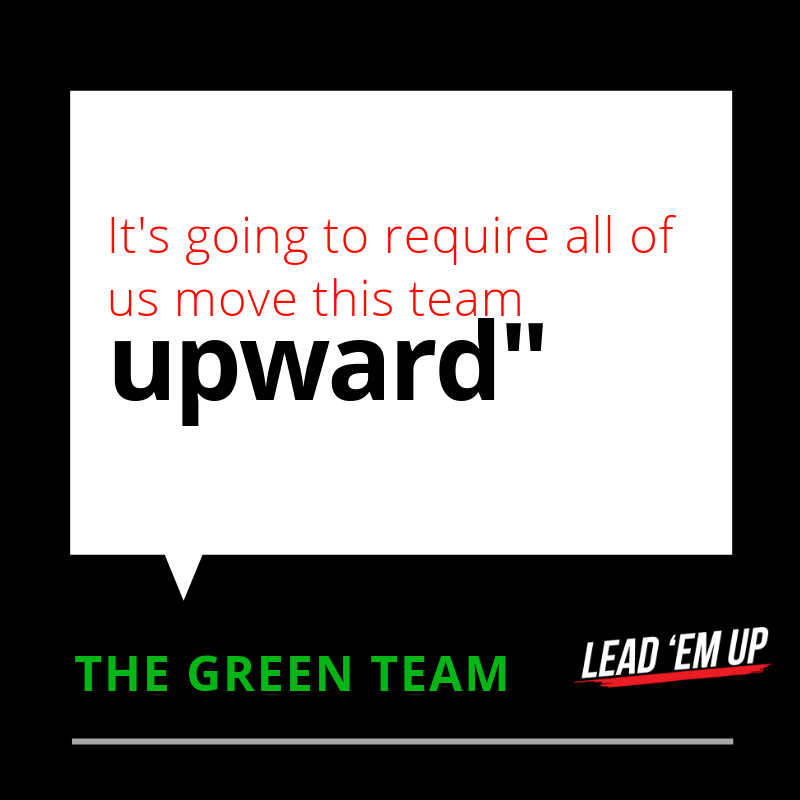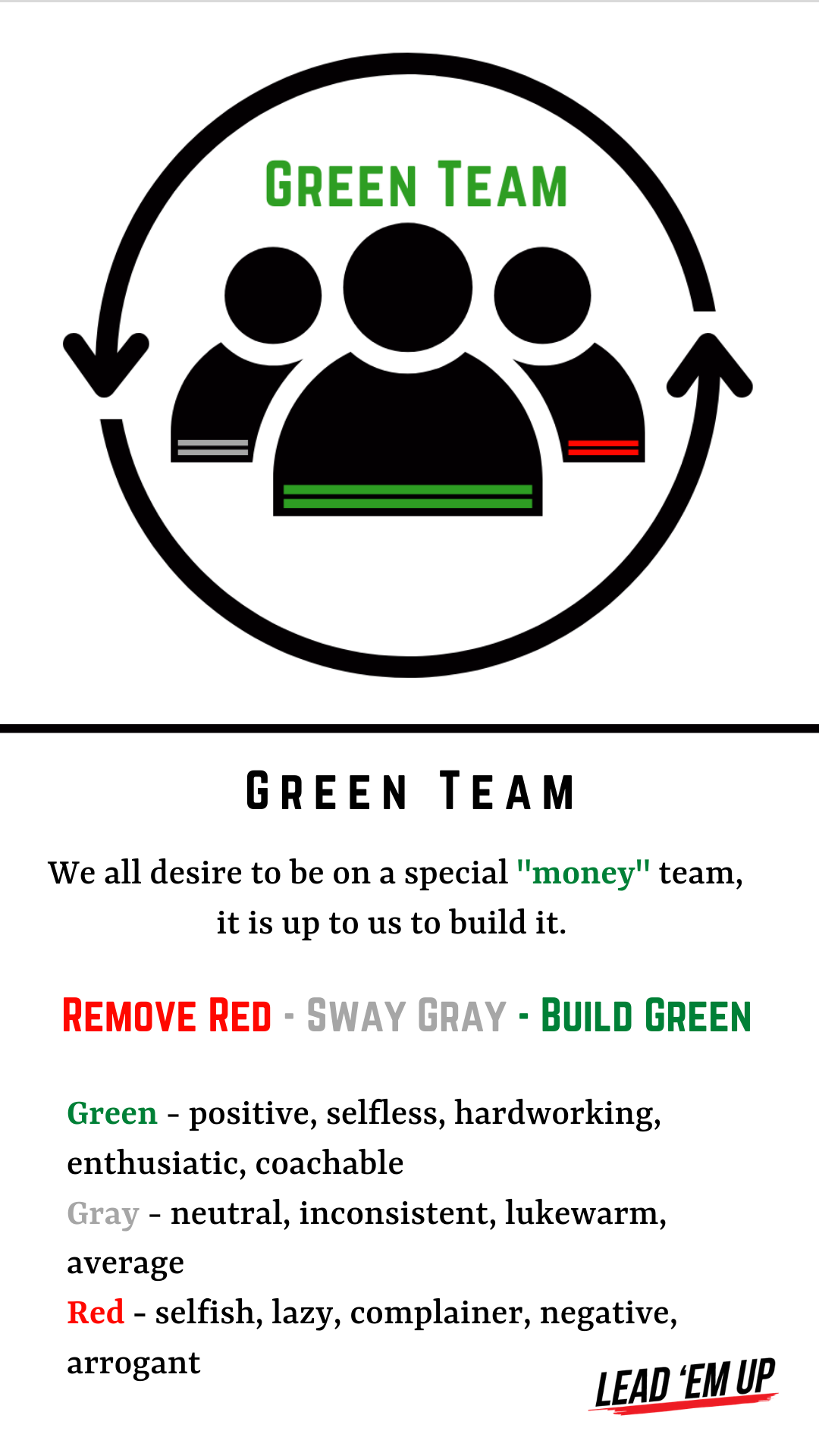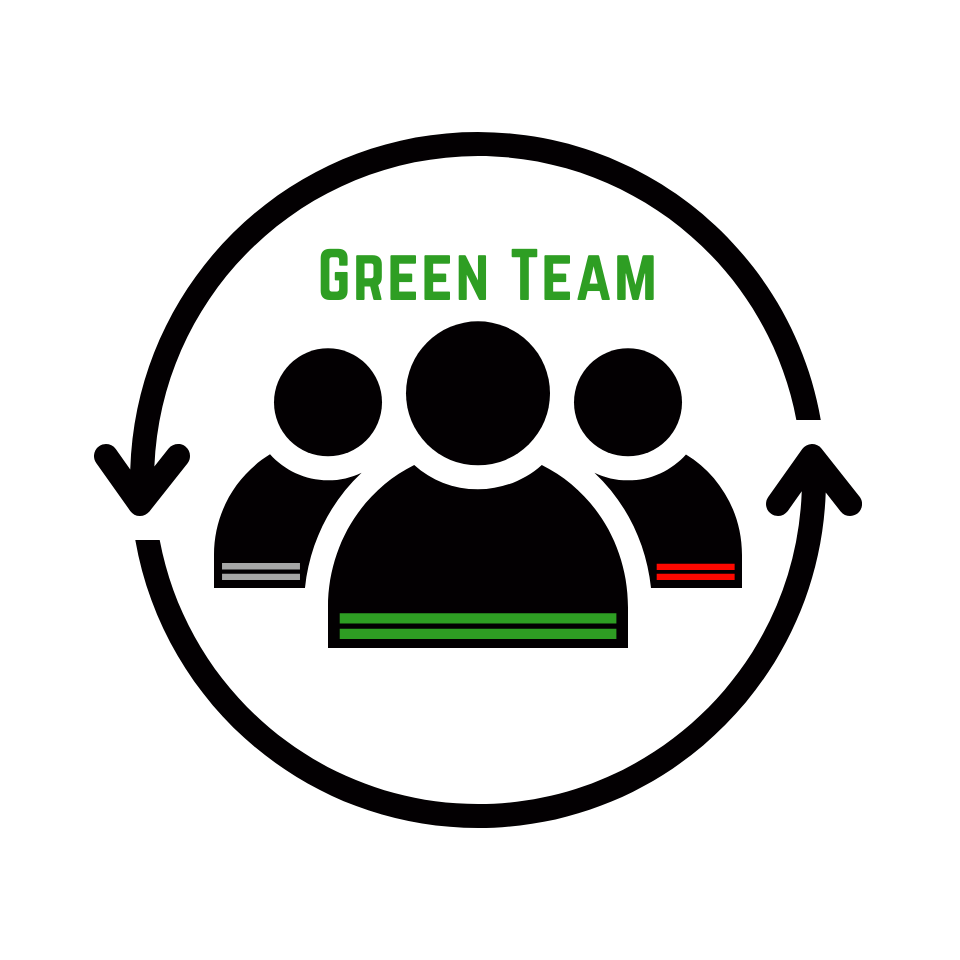

Overview
The Green Team serves as the framework for your team’s leadership and character performance. When a team successfully builds their Green Team you will see a group of players actively moving the team forward and creating a culture that produces winning.
The Green Team also serves as the 1st level of accountability (2nd being Lifeguards and 3rd being “The 6” exercise) getting everyone working towards building the Green Team.
- Players will have a clear vision of what a special team should look like
- The players will be provided with unique language to help guide their leadership and character performance
- The players will understand the mission of removing Red, sway Gray, and building Green

Watch 2 Win Video
Lesson Plan
Green Team Lesson Plan
Before you begin make sure you’ll have a teaching board available (smartboard, whiteboard, or chalkboard)
The Green Team is a Leadership and Character performance framework:
- Leadership: what we do (our actions and behaviors)
- Character: who we are (our character traits)
All teams are broken into three parts; Red, Gray, and Green. Break down the three parts with your players.
Start with Green
Green represents “money.” Money in today’s youthful vocabulary has become a synonym for the word “special” (our team is money, that touchdown was money, etc.) and “special” is our focus. When our players live in the Green; there’s a good chance our team will be money/special (those two terms are interchangeable, embrace whichever one your players will embrace greater).
Ask the team to think about a player they’ve played with at some point in their life (any team, any sport) they’d consider to be special. Remind them, Green Team is a leadership and character performance scale, so we want to think about special people, not necessarily special talents/athletes.
Go around the room and have them share who comes to mind and why. Allow for a couple of minutes to share. As players share, the team will be gaining a better understanding of what special teammates look like.
Now ask them to build out a list of 10-15 character traits to describe the people they were just speaking about. Write the Green traits on the board (save this list – you will need it to complete the Green Standards exercise). You’ll hear traits like Selfless, Positive, Supportive, Hardworking, Coachable, Humble, Passionate, Disciplined, Committed, etc., These Green traits are traits that drive us closer to winning.
Amazing if we lived Green every day, but that’s not always the case.
Now onto Red
Ask the team the following question: “in business, if they say someone’s business is in the Red, what does that mean?”
It means the business is losing money. So if Green is “money” then Red is “losing money.”
It essentially means the business isn’t doing well, they aren’t reaching their full potential, things are unhealthy, distractions exist, challenges are present, etc.
This happens on teams as well. Sometimes our teams are filled with players that cause us not to reach our full potential, create an unhealthiness, become a distraction and cause challenges for our team.
These players are representing Red behavior. Ask the players to raise their hand if they’ve every had a teammate that’s been challenging, caused distractions and brought us down rather than building us up. All hands will go up!
Now ask them to build out a list of 10-15 character traits to describe the people they were just thinking about as they raised their hands. Write the Red traits on the board. You’ll hear traits like Negative, Arrogant, Selfish, Lazy, Toxic, Close-Minded, Pessimistic, Energy-Drainer, etc., These Red traits are traits that drive us further from winning.
Then you have Gray
The Gray is where the majority of our players live.
They like it, but don’t love it. They are in, but not “all-in.” They push themselves but rarely go out of their comfort zone.
Grays participate, play a role on the team, and can often experience success. Unfortunately, they aren’t able to reach their full potential. Gray’s frustrate us because we all know if they would just (insert Green trait; be more committed, be more hardworking, be more disciplined, etc.) they could be so much more, but they haven’t taken that final step. Gray’s are incredible at doing “just enough” to do well but “not enough” to be special.
That is the overview of the Green Team breaking down the Green, Gray, and Red sections.
Now that the players have a baseline of understanding, it’s now time for the players to put the Green Team into action. Their Green Team mission statement is 6 words:
Remove Red – Sway Gray – Build Green
The players need to hold onto the mission statement to help them accomplish the mission.
To help them understand what the mission is going to take, they need to know the 7 rules to building the Green Team.
Go through each rule with the team, engaging in discussion on each of the 7 rules.
- In order to build Green, you must first be Green
This serves as a reminder that leadership isn’t about you, but it starts with you. It’ll be very hard to get others in the green if the athlete can’t get themselves in the green. - If you are a floater, you are the lower of the two levels you float between
Most athletes float – one day they’re green, next day they’re Gray. One day they’re Gray, the next day they’re Red. One day they’re green, the next day they’re Red. They’re a floater. We make it very clear, in order to be “green” the person needs to be green 90% of the time. - Those in the Gray WILL sway. But they could sway Green or Red
Reminds us those around us can absolutely be led, we all can, but if not careful, they could be led in a negative direction. - The more people on the Green team, the easier it is to build a Green team
This rule reminds us we need everyone on board. Everyone will play a role in helping build our green team. The more people we have on board, the more influence and leadership we’ll have in the room moving people in the green direction. - Those in the Red are great recruiters
Misery loves company you often hear, Reds will try to bring others down to the Red. Reminder for the players: don’t get recruited and if you see recruiting happening, shut it down. - You have to fight every day to build a Green Team
We use the word “fight” because it reminds us it won’t be easy. It’s not easy building a green team and it’s not easy showing up green every day. It’s easier to be Red than to be green so if you’re not fighting for green, you’ll default to Red. - Grays live in a very safe space but nothing special can be built there
Gray is comfortable. There’s no risk or vulnerability. Gray’s don’t stand out in a positive or negative way. Gray’s choose safe over special. Gray athletes need to understand by choosing to hold back and live in the Gray, they are missing out on all special green provides. We say green teams change your life because they produce a memory that’ll last.
Remind the players the goal will be to get the team living in the Green when our team needs to be our best. Reference the need to build the Green Team all season. Make plans to come back to the Green Team through the season and check the status of your current breakdown – the goal is to see improvement and grow the Green Team % through the season.
Challenge the players to spend time thinking about where they currently live; Green, Gray, or Red (remembering they’re the lower of the two they float between).
This teaching exercise will create a new mindset in your players.
After the session and during various conversations throughout the season; discuss the green team with your players. Get their opinion on which players are where and how to best move them up. This is also a great exercise with the captains. Have the captains go through your roster together identifying and discussing which players fall where. As they begin realizing the majority of their team is not in green, it’ll provide a challenge for them to begin working to get them up a level.
Player Growth Areas
Exercise Length
Language Guide
Green
An individual who actively demonstrates the traits of selflessness, enthusiasm, hardworking, humility, and positivity
Red
An individual demonstrating traits of selfishness, laziness, arrogance, frequent complaining and low levels of enthusiasm, creating challenges for the team and teammate
Gray
An individual who is lukewarm with varying levels of inconsistency that is performing at a moderate level in areas of leadership and character
Additional Resources
Exercise Reminder Card
To emphasize and reinforce the lessons learned in this exercise with your players, download and share this graphic with them 24 hours after completing the exercise.
Exercise Slides
Powerpoint slides ready for you to use
Quiz Questions
Use these questions below to engage after you have taught the exercise.
- On average, teams start with what percentage in the Green?
- If you are a floater, where do you go?
- Gray is safe but nothing _______________.
At Home
Coaches, use the below question, reflection, and action to engage parents, guardians, and other family members in the lessons learned in this exercise.
Suggestions on how to use: Email to parents the day you have taught this lesson, add it to the materials you send home, or text it to text message threads with your players.
- Question: What does it mean to be Green?
- Reflection: What do you imagine your experience would be like if this year’s team was able to become Green?
- Action: Share how you plan to show up Green on a consistent basis this season.
Teacher Reflection
Take a moment to reflect on the lesson and how you can lead by example to your students.
To get more exercises like this, check out our Coaches Membership
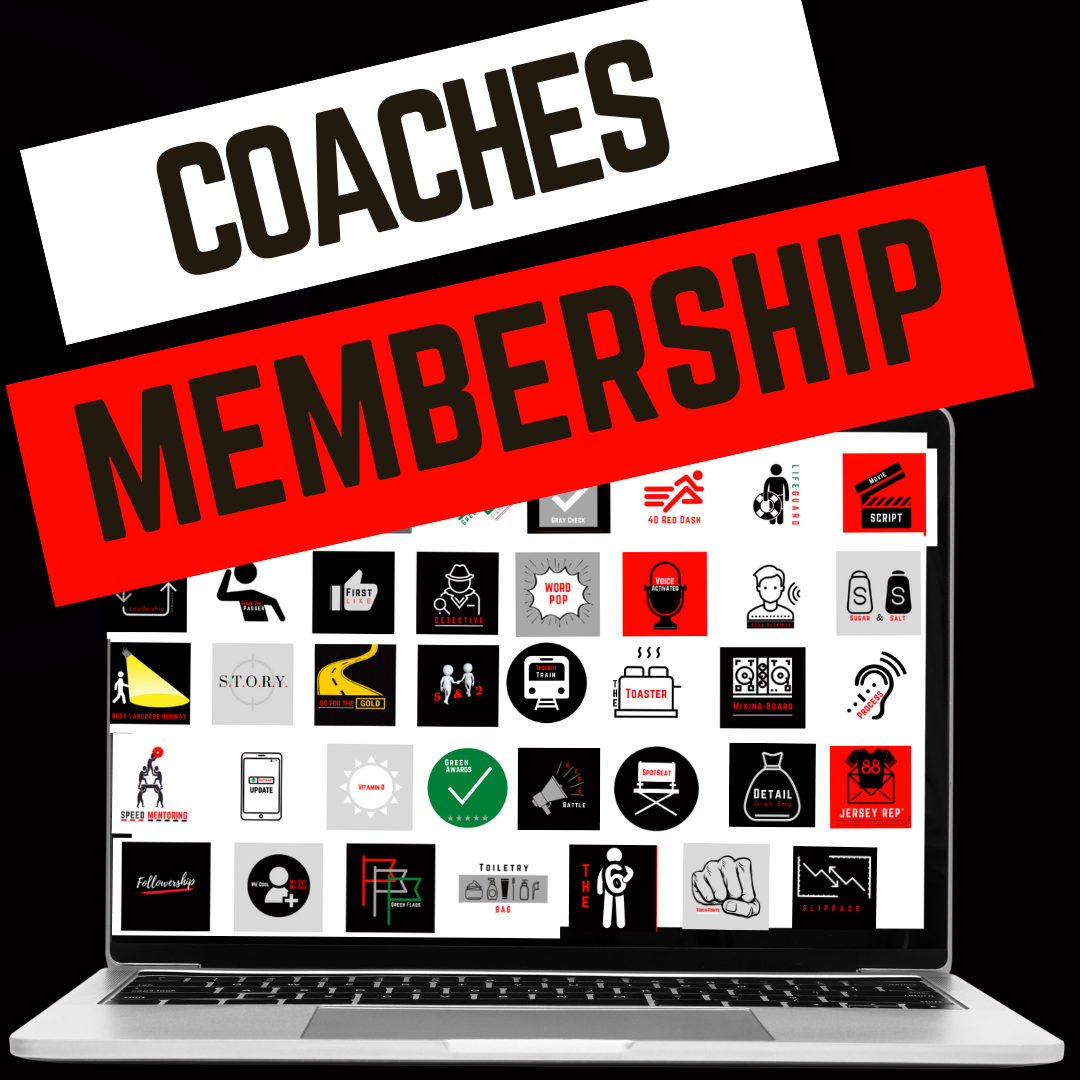
Coaches Membership
Everything, and we mean EVERYTHING you and your team need to develop into the leaders needed to win.


